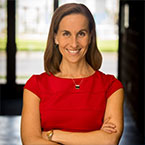By: Laura Jana, MD, FAAP & Jennifer Shu, MD, FAAP
Some parents choose to read to their newborns even before they can hold their heads up or focus their eyes on the pages. Some start even sooner—reading to their
unborn children through uterine walls.
Our take on this head start? Although babies are thought to be able to hear well before they are born, we wouldn't count on it making your baby significantly smarter or more well-read. If you enjoy it, though, by all means, read away in anticipation of the day when your baby will be able to join in on the fun more actively.
The good news is you won't have to wait too long. Just as there are well-defined and eagerly anticipated "motor" milestones that include rolling (4 to 6 months), sitting (7 to 9 months), and walking (anywhere from 9 to 15 months), there are equally well-defined and important milestones of early literacy.
Showered by books
If you ask us, there's no better way to decorate a nursery than by lining your baby's bookshelf with a new collection of favorite children's books. Reach out to friends, family, and anyone else you can think of and ask them to share the name(s) of their favorite children's books. Start collecting a few just for fun in anticipation, and remember to put them on your baby registry. If you're fortunate enough to have someone offer, you can even suggest a book-themed baby shower.
Book-based milestones in babies & toddlers
For the sake of making this short and sweet, we listed some of the book-related behaviors of early childhood, many of which have been developed by one of the country's most widely respected early literacy programs,
Reach Out and Read. That way, you can recognize and celebrate each book-based milestone in the months to come.
Around 3 months: Let the games begin. Your baby will begin to babble and imitate sounds and smile at the sound of your voice. With their head held higher than in months past, they should now be developing a better grasp not only of what you're reading to them (or at least the expressions on your face) but also the books themselves as they learn to swipe at objects and attempts to bring them to their mouth.
Around 6 to 12 months: Taking an active interest. Between the ages of 6 and 12 months, your baby will develop many new skills. This includes the ability to sit up tall with his head steady and grab at pages. Don't be surprised if books end up in your baby's mouth. This is not only to be expected but a good sign that they are interested in books and wants to explore them further. This is the time to invest in some durable board and bath books, if you haven't already, as they stand up the best to new teeth and drool and also contain plenty of color, simple objects, and photographs of faces that babies seem to prefer.
Around 12 to 18 months: A hands-on experience. Not only should your baby be able to sit without support, allowing him both hands free for holding books and turning board pages (albeit several at a time), but they are likely to demonstrate their already well-developed love of reading by carrying their books around, eagerly handing them to you to read, and answering your questions of "Where is the…?" by pointing to pictures with one finger. At this age, toddlers also learn to recognize when a book is upside down. If you've never thought about it before, this is actually a fundamentally important step toward reading!
Around 18 to 24 months: Taking charge. By now your baby will not only have turned into a toddler but also a true book connoisseur adept at turning their own board-book pages. Paper pages may still take a while to fully master. Ask "What's that?" and your toddler is sure to respond by naming familiar pictures. Pause before completing the sentence in a favorite book, and your toddler will finish it for you. Listen in and you'll even hear them taking over your role as storyteller as they start to recite the stories they knows best to their own loyal listeners (i.e., dolls or stuffed animals).
More information:
About Dr. Jana
 Laura A. Jana, MD, FAAP, is a pediatrician and mother of 3 with a faculty appointment at the Penn State University Edna Bennett Pierce Prevention Research Center. She is the author of more than 30 parenting and children's books and serves as an early childhood expert/contributor for organizations including the Maternal and Child Health Bureau, Primrose Schools, and
US News & World Report. She lives in Omaha, NE. Laura A. Jana, MD, FAAP, is a pediatrician and mother of 3 with a faculty appointment at the Penn State University Edna Bennett Pierce Prevention Research Center. She is the author of more than 30 parenting and children's books and serves as an early childhood expert/contributor for organizations including the Maternal and Child Health Bureau, Primrose Schools, and
US News & World Report. She lives in Omaha, NE.
|
About Dr. Shu
 Jennifer Shu, MD, FAAP serves as the medical editor of HealthyChildren.org and provides oversight and direction for the site in conjunction with the staff editor. Dr. Shu is a practicing pediatrician at Children's Medical Group in Atlanta, Georgia, and she is also a mom. She earned her medical degree at the Medical College of Virginia in Richmond and specialized in pediatrics at the University of California, San Francisco. Her experience includes working in private practice, as well as working in an academic medical center. She served as director of the normal newborn nursery at Dartmouth-Hitchcock Medical Center in New Hampshire. Dr. Shu is also co-author of
Food Fights and
Heading Home with Your Newborn published by the American Academy of Pediatrics (AAP).
Jennifer Shu, MD, FAAP serves as the medical editor of HealthyChildren.org and provides oversight and direction for the site in conjunction with the staff editor. Dr. Shu is a practicing pediatrician at Children's Medical Group in Atlanta, Georgia, and she is also a mom. She earned her medical degree at the Medical College of Virginia in Richmond and specialized in pediatrics at the University of California, San Francisco. Her experience includes working in private practice, as well as working in an academic medical center. She served as director of the normal newborn nursery at Dartmouth-Hitchcock Medical Center in New Hampshire. Dr. Shu is also co-author of
Food Fights and
Heading Home with Your Newborn published by the American Academy of Pediatrics (AAP).
|